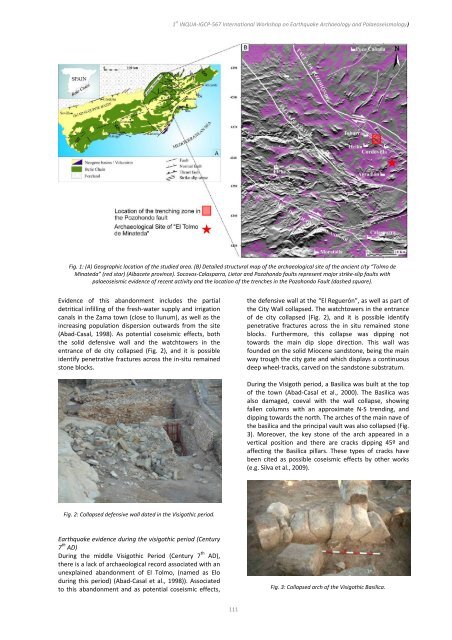Archaeoseismology and Palaeoseismology in the Alpine ... - Tierra
Archaeoseismology and Palaeoseismology in the Alpine ... - Tierra
Archaeoseismology and Palaeoseismology in the Alpine ... - Tierra
You also want an ePaper? Increase the reach of your titles
YUMPU automatically turns print PDFs into web optimized ePapers that Google loves.
1 st INQUA‐IGCP‐567 International Workshop on Earthquake Archaeology <strong>and</strong> <strong>Palaeoseismology</strong>)<br />
Fig. 1: (A) Geographic location of <strong>the</strong> studied area. (B) Detailed structural map of <strong>the</strong> archaeological site of <strong>the</strong> ancient city “Tolmo de<br />
M<strong>in</strong>ateda” (red star) (Albacete prov<strong>in</strong>ce). Socovos‐Calasparra, Lietor <strong>and</strong> Pozohondo faults represent major strike‐slip faults with<br />
palaeoseismic evidence of recent activity <strong>and</strong> <strong>the</strong> location of <strong>the</strong> trenches <strong>in</strong> <strong>the</strong> Pozohondo Fault (dashed square).<br />
Evidence of this ab<strong>and</strong>onment <strong>in</strong>cludes <strong>the</strong> partial<br />
detritical <strong>in</strong>fill<strong>in</strong>g of <strong>the</strong> fresh‐water supply <strong>and</strong> irrigation<br />
canals <strong>in</strong> <strong>the</strong> Zama town (close to Ilunum), as well as <strong>the</strong><br />
<strong>in</strong>creas<strong>in</strong>g population dispersion outwards from <strong>the</strong> site<br />
(Abad‐Casal, 1998). As potential coseismic effects, both<br />
<strong>the</strong> solid defensive wall <strong>and</strong> <strong>the</strong> watchtowers <strong>in</strong> <strong>the</strong><br />
entrance of de city collapsed (Fig. 2), <strong>and</strong> it is possible<br />
identify penetrative fractures across <strong>the</strong> <strong>in</strong>‐situ rema<strong>in</strong>ed<br />
stone blocks.<br />
Fig. 2: Collapsed defensive wall dated <strong>in</strong> <strong>the</strong> Visigothic period.<br />
Earthquake evidence dur<strong>in</strong>g <strong>the</strong> visigothic period (Century<br />
7 th AD)<br />
Dur<strong>in</strong>g <strong>the</strong> middle Visigothic Period (Century 7 th AD),<br />
<strong>the</strong>re is a lack of archaeological record associated with an<br />
unexpla<strong>in</strong>ed ab<strong>and</strong>onment of El Tolmo, (named as Elo<br />
dur<strong>in</strong>g this period) (Abad‐Casal et al., 1998)). Associated<br />
to this ab<strong>and</strong>onment <strong>and</strong> as potential coseismic effects,<br />
111<br />
<strong>the</strong> defensive wall at <strong>the</strong> “El Reguerón”, as well as part of<br />
<strong>the</strong> City Wall collapsed. The watchtowers <strong>in</strong> <strong>the</strong> entrance<br />
of de city collapsed (Fig. 2), <strong>and</strong> it is possible identify<br />
penetrative fractures across <strong>the</strong> <strong>in</strong> situ rema<strong>in</strong>ed stone<br />
blocks. Fur<strong>the</strong>rmore, this collapse was dipp<strong>in</strong>g not<br />
towards <strong>the</strong> ma<strong>in</strong> dip slope direction. This wall was<br />
founded on <strong>the</strong> solid Miocene s<strong>and</strong>stone, be<strong>in</strong>g <strong>the</strong> ma<strong>in</strong><br />
way trough <strong>the</strong> city gate <strong>and</strong> which displays a cont<strong>in</strong>uous<br />
deep wheel‐tracks, carved on <strong>the</strong> s<strong>and</strong>stone substratum.<br />
Dur<strong>in</strong>g <strong>the</strong> Visigoth period, a Basilica was built at <strong>the</strong> top<br />
of <strong>the</strong> town (Abad‐Casal et al., 2000). The Basilica was<br />
also damaged, coeval with <strong>the</strong> wall collapse, show<strong>in</strong>g<br />
fallen columns with an approximate N‐S trend<strong>in</strong>g, <strong>and</strong><br />
dipp<strong>in</strong>g towards <strong>the</strong> north. The arches of <strong>the</strong> ma<strong>in</strong> nave of<br />
<strong>the</strong> basilica <strong>and</strong> <strong>the</strong> pr<strong>in</strong>cipal vault was also collapsed (Fig.<br />
3). Moreover, <strong>the</strong> key stone of <strong>the</strong> arch appeared <strong>in</strong> a<br />
vertical position <strong>and</strong> <strong>the</strong>re are cracks dipp<strong>in</strong>g 45º <strong>and</strong><br />
affect<strong>in</strong>g <strong>the</strong> Basilica pillars. These types of cracks have<br />
been cited as possible coseismic effects by o<strong>the</strong>r works<br />
(e.g. Silva et al., 2009).<br />
Fig. 3: Collapsed arch of <strong>the</strong> Visigothic Basilica.



